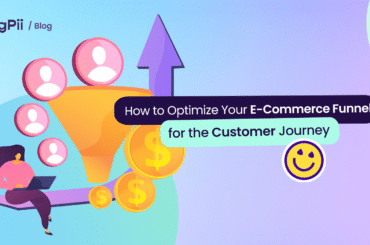Did you know that the hidden power of Conversion Rate Optimization (CRO) can unlock the full potential of your website and skyrocket your business success? In this blog post, we will explore the fascinating world of CRO, its numerous direct and indirect benefits, and the tools and resources that can help you effectively optimize your website for increased conversions and customer satisfaction. Discover the benefits of conversion rate optimization and how it can transform your online presence.
Key Takeaways
- Conversion Rate Optimization (CRO) is an effective tool to improve website performance and increase conversions.
- CRO strategies can provide direct benefits such as higher conversion rates, improved user experience, and increased customer trust.
- Businesses should leverage analytics tools, testing tools, and expert resources to maximize the value of their website traffic & drive long-term growth.
The Power of Conversion Rate Optimization
Conversion Rate Optimization (CRO) is a powerful tool for businesses looking to improve website performance, increase conversions, and enhance user experience. Through the analysis of user behavior, examination of various website elements, and making decisions influenced by data, an effective optimization of your website can be achieved using conversion rate optimization tools. This leads to a higher conversion of visitors into customers, which ultimately boosts revenues and fosters business growth.
CRO is not without its challenges and misconceptions, but with the right approach, it can be a game-changer for your business. The main goal of CRO is to improve a site’s conversion rate, and success lies in understanding the key components of CRO and implementing the right strategies.
Understanding CRO
CRO revolves around the analysis of user behavior, carrying out experiments on diverse website elements, and utilizing data to make decisions, all aimed at elevating conversion rates. Measuring conversion rates provides valuable data on your site’s past and current performance, which can be leveraged to increase leads, customers, and revenue for your business.
Elevating conversion rates requires the establishment of key metrics, collection of user feedback and data, and execution of A/B tests that refine different pages and components on your website. The ultimate aim of CRO is to enhance sales by optimizing website performance and converting visitors to customers, especially for eCommerce sites, where generating sales is the primary goal.
Key Components of CRO
Successful CRO strategies focus on several essential components, including:
- Landing page design
- Website copy
- Call-to-action
- Navigation
- Forms
- Page speed
- Landing pages
By optimizing these elements, businesses can create a seamless and user-friendly website experience for their web pages, ultimately leading to increased conversions.
A well-executed CTA strategy plays a vital role in enhancing conversions. For example, ADT experienced a 60% conversion rate boost by modifying the primary text of its CTA button. Additionally, optimizing page load speed is important, as a one-second delay can lead to a 7% reduction in conversions. By focusing on these key components, businesses can effectively enhance their website’s conversion rate and overall performance.
Direct Benefits of Conversion Rate Optimization (CRO)
CRO offers numerous direct benefits to businesses, such as higher conversion rates, improved user experience, and increased customer trust. With a concentration on the optimization of website elements and user flow, CRO can efficiently generate more sales leads and foster overall business expansion.
Higher Conversion Rates
CRO helps businesses increase the percentage of visitors who complete desired actions, leading to more sales and leads. ShowPo, an Australian-based eCommerce company, implemented A/B tests and improved variants on its product pages. This resulted in a 6.09% increase in revenue.
Through optimizing conversion rates, businesses can:
- Extract maximum value from their existing audience
- Draw in fresh customers, thereby fostering scalable and sustainable expansion
- Improve customer loyalty and advocacy, driving long-term business success.
Higher conversion rates are crucial for businesses to achieve their goals and optimize their performance within the conversion funnel; it’s essential to calculate the conversion rate for a site accurately. By implementing conversion optimization strategies, businesses can further enhance their site’s conversion rate.
Improved User Experience
CRO, by optimizing website elements and user flow, amplifies the overall user experience, which in turn leads to an elevation in engagement and customer satisfaction. A well-crafted user experience reduces friction, optimizes navigation, and provides clear calls to action, making it easier for users to convert. Furthermore, a positive user experience can result in increased customer loyalty and advocacy, thereby driving conversion rates.
For augmenting user experience, businesses ought to concentrate on the following:
- Design consistency and layout
- Mobile Optimization
- Page speed
- An intuitive interface
- Usability
- Learnability
- Effective functionality
- Efficiency
- Memorable and desirable design elements
By prioritizing user experience in CRO, businesses can reap the benefits of higher conversion rates and increased customer satisfaction.
Increased Customer Trust
CRO helps build trust with potential customers by providing a seamless and user-friendly website experience. When users have a positive experience, they are more likely to trust the brand and complete desired tasks, such as making a purchase or filling out a form.
Businesses can build customer trust through various CRO strategies, such as showcasing testimonials, reviews, and case studies to establish credibility. Through the provision of a smooth, user-friendly website experience, businesses can effectively amplify customer trust, which results in a rise in conversion rates and ensures long-term success.
Indirect Benefits of CRO
CRO also offers indirect benefits, including boosted SEO performance, enhanced marketing ROI, and scalability and sustainability. Focusing on the optimization of website engagement metrics and user experience, CRO can indirectly influence search engine rankings, contributing to sustained business success.
Boosted SEO Performance
CRO indirectly benefits SEO by improving website engagement metrics, such as click-through rates, dwell time, and conversion rates. Optimizing for these metrics, in addition to improving user experience and increasing user engagement, can improve a website’s visibility and organic traffic.
Higher engagement rates and improved user experience may result in higher rankings in search engine results pages, driving more traffic to your website and ultimately increasing conversions. By focusing on CRO, businesses can not only enhance their website’s conversion rate but also boost its SEO performance, leading to long-term growth and success.
Enhanced Marketing ROI
Through the optimization of conversion rates, CRO assists businesses in extracting more value from their marketing efforts, leading to an increased return on investment. An increased conversion rate contributes to marketing ROI by reducing the cost per acquisition, augmenting revenue, and optimizing efficiency in the marketing funnel.
CRO allows businesses to:
- Optimize the value of their existing website traffic
- Decrease costs for further marketing
- Consistently monitor analytics
- Adapt strategies based on results
- Ensure that their CRO strategies are effective and successful
- Enhance marketing ROI
Scalability and Sustainability
CRO allows businesses to optimize their existing audience and draw in new customers, contributing to scalable and sustainable growth. By enhancing the efficiency of their website or marketing campaigns, businesses can draw in more customers and generate more revenue, enabling them to scale their operations and broaden their reach.
Furthermore, CRO can lead to improved customer experiences, heightened customer satisfaction, and strengthened brand loyalty, all of which are key components of long-term business sustainability. By focusing on CRO, businesses can achieve scalable and sustainable growth, ensuring long-term success in an ever-changing digital landscape.
Implementing CRO Strategies
To implement CRO strategies, businesses should follow a systematic process that involves:
- Identifying areas for improvement
- Conducting testing and experimentation
- Measuring results
- Adjusting accordingly
Adopting this approach can enable businesses to effectively optimize their ecommerce site, leading to an increase in the desired action of conversions and customer satisfaction, as well as attracting more website visitors to their web page.
Identifying Areas for Improvement
Analyzing website data and user behavior can help businesses pinpoint areas that need optimization, such as high-traffic or underperforming pages. Businesses can obtain a profound understanding of their audience and spot potential areas for enhancement through the collection of qualitative and quantitative data via surveys, interviews, user testing, and analytics tools.
Once potential areas for improvement have been identified, it’s crucial for businesses to prioritize the elements they wish to test and organize their testing strategy accordingly. Businesses can more effectively optimize their website and achieve superior results by prioritizing the most impactful changes initially.
Testing and Experimentation
To determine the most effective website changes for increasing conversions, businesses should employ testing tools like Optimizely and VWO for conducting A/B tests, multivariate tests, and other experiments, including split testing. A/B testing involves comparing two versions of the same webpage to determine which yields the most favorable outcomes, while multivariate testing simultaneously examines multiple variables to identify the combination that yields the most optimal outcome.
Experiments should be allowed to progress until they reach statistical significance, which will ensure the results accurately represent the interaction of a larger population with the website. If an experiment appears unsuccessful, businesses should conduct a thorough examination, address any issues, and re-run the experiment to reach a definitive result.
Measuring Results and Adjusting
Continuously monitoring analytics and adjusting CRO strategies based on results is crucial to ensuring ongoing improvement and success. By leveraging data-backed insights, experimenting with various strategies, and interpreting data accurately, businesses can effectively adjust their CRO strategies and achieve better results.
Maintaining a proactive attitude towards CRO and demonstrating flexibility in adapting strategies based on the data gathered is critical. By consistently measuring results and adjusting CRO strategies, businesses can achieve continuous improvement in their website’s conversion rate and overall performance.
Top CRO Tools and Resources
To optimize conversion rates effectively, businesses should utilize various CRO tools and resources, such as analytics tools, testing tools, and expert resources. By leveraging these tools and resources, businesses can gain valuable insights, conduct experiments, and learn from industry experts to enhance their website’s performance and achieve better results.
Analytics Tools
Analytics tools like Google Analytics and heat maps can provide valuable data on user behavior and website performance, enabling businesses to:
- Identify areas for improvement
- Test different strategies to optimize their conversion rate
- Track and measure key metrics, such as conversion rates, bounce rates, and user engagement
- Make data-driven decisions
- Enhance the conversion process
These tools enable businesses to gather insights and make informed decisions to improve their website’s performance, increase conversions, and better understand their site visitors.
Consistent monitoring of website analytics and acting on the insights obtained can allow businesses to effectively optimize their website, leading to increased conversions and customer satisfaction. Analytics tools are an essential component of any successful CRO strategy, providing businesses with the data they need to make informed decisions and achieve better results.
Testing Tools
Testing tools like Optimizely and VWO enable businesses to conduct A/B tests, multivariate tests, and other experiments to determine the most effective website changes for increasing conversions. These tools allow users to easily create and test different variations of their website, allocate traffic between different versions of a webpage, and compare their outcomes to identify the most successful variation.
In addition to Optimizely and VWO, other CRO testing tools are available, such as:
- AB Tasty
- Dynamic Yield
- Yieldify
- OptiMonk
- Adobe Target
- Convert
- Omniconvert
- Kameleoon
- Crazy Egg
- Monetate
The employment of these testing tools can enable businesses to experiment effectively with various website changes and optimize their conversion rates, leading to an increase in sales and leads.
Expert Resources
Accessing expert resources, such as case studies, guides, and online courses, can help businesses learn more about CRO best practices and strategies. By studying the experiences of industry experts and thought leaders like Peep Laja, Csaba Zajdo, Joanna Wiebe, Justin Rondeau, Eric, Laura Stude, Tommy Walker, and Bryan Eisenberg, businesses can gain valuable insights into effective CRO techniques and methodologies.
Additionally, online forums and communities, such as SiteSpect, LinkedIn, and Warrior Forum, offer opportunities to discuss and share CRO best practices with other professionals in the field. Leveraging expert resources can help businesses stay abreast of the latest CRO trends and persistently improve their website’s performance and conversion rates.
Summary
In conclusion, Conversion Rate Optimization is a powerful tool that can unlock the full potential of your website and drive business success. By understanding the key components of CRO, implementing effective strategies, and utilizing top CRO tools and resources, businesses can optimize their website for increased conversions, customer satisfaction, and long-term growth. It’s time to harness the power of CRO and take your business to new heights!
Frequently Asked Questions
What are the advantages of conversion rate optimization?
Conversion rate optimization helps to segment your users and funnel them towards the products or services that best meet their needs, resulting in more repeat customers and higher value. Additionally, it reduces customer acquisition costs by increasing revenue per visitor and acquiring more customers for your business.
How conversion rate optimization can help your business?
Conversion rate optimization can significantly increase your marketing ROI by converting more visitors into paying customers. It can be a cost-effective way to maximize the return from each dollar spent on marketing.
What are the objectives of conversion rate optimization?
Conversion rate optimization (CRO) is the process of increasing the percentage of website visitors who complete a desired action, with the overall goal of acquiring more customers and growing the business. This is done by using user insights and analytics to improve key performance indicators, such as revenue per visitor.
How does CRO impact SEO performance?
CRO enhances website engagement metrics like click-through rates, dwell time, and conversions, which can, in turn, lead to improved SEO performance.
What tools can be used for analytics in CRO?
Google Analytics and heat maps are two powerful tools often used for analytics in CRO, enabling businesses to make informed decisions when optimizing their website.



